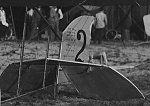gzt napisał(a):I did not see this craft before, however the fist thing I noticed were the ailerons. This design will have (may have) undesirable effect with larger ages of attack. "Regular" ailerons will work quite normal due to the flow at the trailing edge of the wind (airfoil). The ailerons used here may generate some nice moment, however soon with a bit higher angle of attack, may create a stall of the wing tip. At this moment the lost of the rolling moment and the lift will take effect.
Just a theory I implemented while looking at this design.
A careful and small deflections of ailerons may work just fine.
Another issue is the rudder; it is pretty small and may be "shaded" during the spin. At this moment it may be very difficult to take it our of the spin.
I am sorry for my text with such errors; my browser wants to correct my writing with ... questionable results :-)
angle of attack - not ages of attack
flow at the trailing edge of the wing - not the wind
Dla tych (sa tacy?) co nie rozumieja po angielsku: pisalem o specyficznie zaprojektowanych lotkach. Wlasnie te zwrocily od razu moja uwage bo tez nigdy nie widzialem tego projektu. Tego typu lotki moga miec niespodziewane dzialanie przy wiekszych katach natarcia - po prostu moze to spowodowac utrate sily nosnej na koncowce skrzydla i zdecydowanie ograniczyc dzialanie lotek. To moze miec wplyw na wejscie w korkociag po przeciagnieciu. Dodatkowo maly ster kierunku bedacy rowniez w cieniu statecznika poziomego, moze spowodowac problemy z wyjsciem z tego korkociagu.
Dodatkowo obejrzalem film z kraksy i widac ze samolot wpada w korkociag PO wejsciu w zakret. Moze to sugerowac ze wlasnie w zakrecie lotki zostaly wychylone poza granice krytycznego kata natarcia i nastapilo oderwanie stug i przeciagniecie oraz korek.






